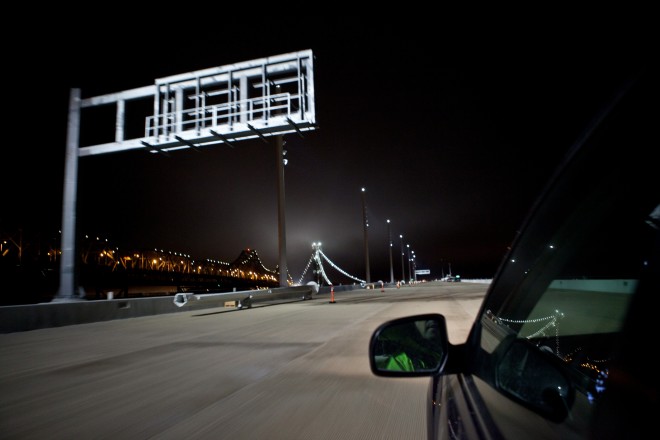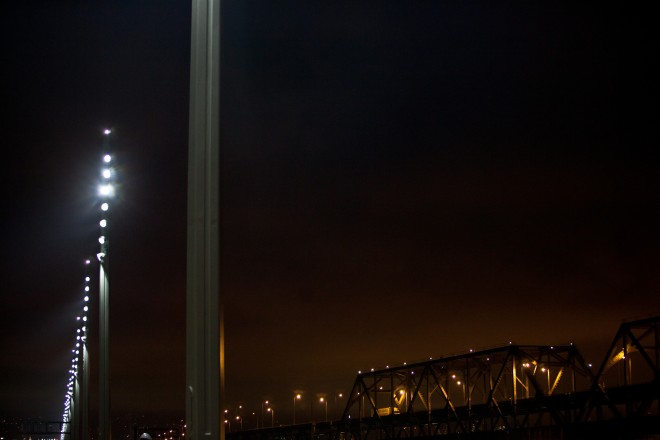For a few minutes on Thursday night, San Francisco's new Bay Bridge was bathed in radiant white light, spilling down from thousands of LEDs, mounted on a new lighting system unlike any other.
Lamps have been making streets safer for driving since before cars were invented. Eventually, they featured hoods to reduce light pollution, and LEDs to increase efficiency. But when Bleyco, the electrical contractor for the new $7 billion bridge from Oakland to San Francisco, decided they wanted the most advanced system ever made, they reached out to a sports-lighting manufacturer, Musco.

The idea was to use cutting-edge directional lighting to carpet the bridge in solid white light, without glare on drivers' windows or patches of dark on the road.
"When Bleyco contacted us about the project, the solution was unknown," said Musco sales manager Adam DeJong. In 2008, when Bleyco first asked Musco to build it, the technology didn't exist.
"The response in 2008 was, No," recalls DeJong. "Then [Bleyco] came back and the response in 2009 was, No. Then, late 2009, we finally said maybe, because they kept hounding us."
But even in 2009, the chip Musco needed to control so many LEDs wasn't available. The company started anyway, building fixtures with 25 to 50 Cree XM-L LEDs and testing them on roads in rural Iowa.
It's not the LEDs that are new — other bridges have retrofitted standard lamps with LEDs — but how Musco used them to direct the light at a specific part of the road. DeJong compares the LED arrays to a series of garden hoses, all raining down on a different spot, as opposed to a fire hose that dumps its entire output in one place. The setup puts the light where they want it, but keeps it from spilling where they don't.

"Every LED is pointing to a different place, it has a differently directed visor, and a different lens," explains Bill Shedd, a senior construction engineer for CalTrans. Not only is each LED unique, the system as a whole is designed to match this bridge specifically.
If it looks like the kind of lighting you'd see at a football game, it should. Musco specializes in sports lighting, from NASCAR to high school football to major league baseball. (Yankee Stadium uses Musco lighting.)
The poles themselves were designed by Valmont Industries with a dampening system. A series of thick metal plates with nylon between them are stacked up inside each pole, near the top, to dampen vibrations. But the poles aren't just utilitarian. Their pentagonal shape was designed to match the bridge's central tower, and even the seven light fixtures per pole are meant to represent the seven struts on the central tower.
Along with safety and aesthetics, the system is made to be long-lasting.
"There's a constant degradation process, over a long time," says Bleyco Vice President Chris Berge. "It's a long, long process in an LED. I think they're projecting 20 years. You could have more degradation just by dirty glass."

Though the lighting for the bridge cost $18 million, the longevity of the bulbs means CalTrans won't have to shut down a lane every couple of years to replace them. Musco, Berge adds, has included a 10-year warranty for parts and labor. A remote programming system means engineers can change the brightness of each fixture from below — say, on the bridge's bike path — without getting in anybody's way.
Driving along the westbound lanes of the bridge, the lights themselves barely showed. The fixtures are on the opposite side of the 20-meter-tall poles from the drivers, so they don't shine in anyone's eyes or cause glare on windshields. The roadway, though, was lit up evenly, blanketed in a white sheet of custom LED light.
Meanwhile, as video teams from local news stations cruised up and down the empty span, a couple hundred feet away, the old Bay Bridge was hulking dimly in the darkness, lit up in scattered yellow splotches.






